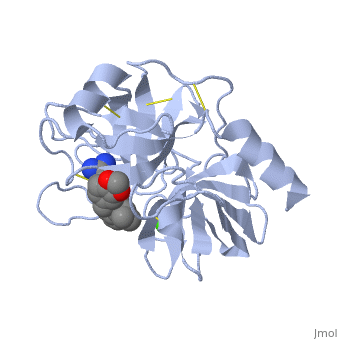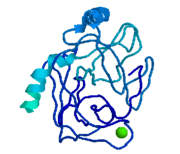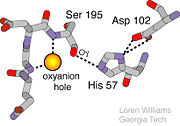Function
Trypsin or serine protease 1 is a medium size globular protein that functions as a pancreatic serine protease. This enzyme hydrolyzes bonds by cleaving peptides on the C-terminal side of the amino acid residues lysine and arginine. It has also been shown that cleavage will not occur if there is a proline residue on the carboxyl side of the cleavage site. Trypsin was first discovered in 1876 by Kuhne, who investigated the proteolytic activity of the enzyme. In 1931 the enzyme was purified by crystallization by Norothrop and Kunitz and later in 1974 the three dimensional structure of trypsin was determined. Throughout the 1990's the role of trypsin in hereditary pancreatitis and the mutation that causes it was discovered. Today trypsin is used in the development of cell and tissue protocols, as well as in the medical field to determine the role of trypsin in pancreatic diseases[1].
- Cationic trypsin or Trypsin-1 is expressed in the pancreas. It cleaves linkages involving lysine and arginine. See Cationic trypsin.
- Anionic trypsin or Trypsin-2 is expressed in the pancreas. It cleaves linkages involving lysine and arginine.
- Mesotrypsin or Trypsin-3 is expressed in brain and pancreas and is resistant to common trypsin inhibitors. It cleaves linkages involving lysine and arginine.
- Trypsinogen is the precursor form or zymogen of Trypsin. Zymogens are enzyme precursors that are made and secreted in the lysosome of the cell. Zymogens are not active until they go through a chemical process such as hydrolysis, cleavage, or other cleavages that reveal the active site. The zymogen precursor is necessary in order to prevent the destruction of cellular proteins and to allow the enzyme to be in it's active state only when in appropriate conditions. Trypsinogen is specifically produced in the exocrine cells of the pancreas. There are three isoforms of Trypsinogen that are secreted by the pancreas. The precursor is only activated when it reaches the lumen of the small intestine. This activation occurs through the help of an enteropeptidase and once activated trypsin stimulates the formation of more trypsinogen[2]. The structure of Bovine Trypsinogen is shown in the figure to the right [3].
Trypsin has many applications due to fact that it is easily purified in high quantities. The trypsin enzyme is often used in the research setting to digest proteins and then identify the resulting peptides using mass spectrometry. Trypsin has many uses in the medical field such as dissolving blood clots and treating inflammation. Other applications include its use in pre-digesting of baby food, fingerprinting and sequencing work, and environmental monitoring [4]. For additional details see
Serine Proteases
Protease
Lotem haleva/test page
Trypsin (Hebrew).
Ligand Binding and Catalysis
The structure of this particular bovine trypsin was determined in complex with , formula C20H29N5O2, along with two (highlighted) and a Calcium ion (green). . The binding of ligand UB-THR 10 involves , direct . The figure below shows this binding in two dimensions.
The binding of trypsin to UB-THR 10 somewhat emulates the binding to its specific peptide substrates. The preference for lysine or arginine in trypsin catalysis is due to the composition of the trypsin . Here (green), Asp 189 and one of two significant glycine backbones, Gly 216, interact with the ligand as they would with Arg or Lys.
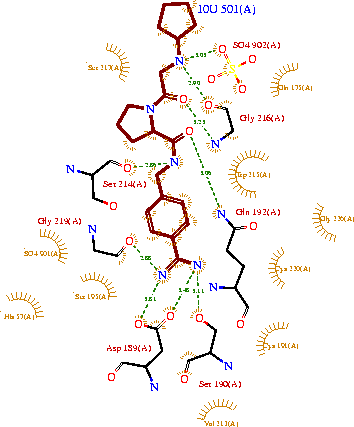
A two-dimensional representation of trypsin binding Ligand UB-THR 10
The ; Asp 102, His 57, and Ser 195, shown here in yellow, is positioned near the substrate. The catalytically active histidine and serine side chains are even near an amide bond in UB-THR 10, just like the amide bond broken in peptide hydrolysis. According to FirstGlance in Jmol, there is no bonding of these groups with the ligand, apart from minor van der Waal's interactions with Hist 57. If Ligand UB-Thr 10 were a transition state analog, some covalent connection would exist in addition to hydrogen bonds. UB-THR 10 simulates the substrate, but does not hydrolyze at either of its two amide bonds, likely due to the local cyclic groups atypical of peptide backbones.
Regulation
Trypsin has long been known as unique in that it is an allosterically regulated monomer [1]. In viewing the 3D structure, the allosteric sight appears to most likely be the subsite loop, which can bind Calcium. New research involving structural comparisons of trypsin-like serine proteases bound and unbound to Calcium and other effectors is being done to better understand the mechanism of this regulation[2].
Catalytic Mechanism
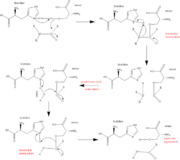
Serine Protease Mechanism
The function of Trypsin is to break down peptides using a hydrolysis reaction into amino acid building blocks. This mechanism is a general catalytic mechanism that all Serine proteases use. The active site where this mechanism occurs in Trypsin is composed of three amino acids and called a catalytic triad. The three catalytic residues are Serine 195, Histidine 57, and Aspartate 102 [5]. The structure of the catalytic triad and the mechanism are shown in the figures to the right. In the mechanism, serine is bonded to the imidazole ring of the histidine. When histidine accepts a proton from serine an alkoxide nucleophile is formed. This nucleophile attacks the substrate when the substrate is present. The role of the aspartate residue is hold histidine in the proper position to make it a good proton acceptor. What makes this mechanism works is that a pocket if formed from the three residues and the three residues function to hold each other in proper position for nucleophilic attack.
The steps of the mechanism involve two tetrahedral intermediates and an Acyl-enzyme intermediate [6]. The mechanism can be followed in more detail in the figure on the right [7].
Oxyanion Hole
An important motif that is formed in this reaction is an oxyanion hole. This is also shown in the figure to the right [8]. This oxyanion hole is specifically formed between the amide hydrogen atoms of Serine 195 and Glycine 193. This oxyanion hole stabilizes the tetrahedral intermediate through the distribution of negative charge to the cleaved amide [9].
Trypsin-BPTI complex
The trypsin backbone is shown in pink and the trypsin inhibitor, BPTI, in yellow (PDB code 2ptc). The residues [Ser195-His57-Asp102-Ser214] are shown in green, the disulfide bond between residues 14-38 is shown in yellow and the Lys 15 sidechain at the specificity site in pink. See also Ann Taylor 115.
Comparison to Chymotrypsin and Elastase
Trypsin, chymotrypsin, and elastase are all digestive enzymes that are produced in the pancreas and catalyze the hydrolysis of peptide bonds. Each of these enzymes has different specificities in regards to the side chains next to the peptide bond. Chymotrypsin prefers a large hydrophobic residue, trypsin is specific for a positively charged residue, and elastase prefers a small neutral residue. Chymotrypsin, trypsin and elastase are all proteins that contain a catalytic mechanism and hydrolyze peptides using the serine protease mechanism. Chymotrypsin and elastase are both homologs of Trypsin since they are 40% alike in structure and composition [10]. In the structure shown the alpha helices are blue, the beta sheets are green, and the remainder of the protein is red. In the structure shown the alpha helices are in red, the beta sheets are yellow, and the remainder of the protein is orange.
The remarkable efficiency of a Pin-II proteinase inhibitor sans two conserved disulfide bonds is due to enhanced flexibility and hydrogen-bond density in the reactive loop [11]
Background: Plant proteinase Inhibitors (PIs) are ubiquitous in the plant kingdom and have been extensively studied as plant defense molecules, which inhibit hydrolytic enzymes (e.g. , colored in darkmagenta) of the insect gut [12]. Among various PI families, Serine PI Pin-II/Pot-II family displays a remarkable structural and functional diversity at the gene and protein level [13]. Wound, herbivory and stress induced up-regulation of these PIs clearly link them to plant defense [12]. Previous studies using transgenic systems or in vivo assays have positively correlated the advantage offered by Pin-II PI expression in plants against insect attack [14] [15]. Precursor proteins of Pin-II PIs consist of 1- to 8- connected by proteolytic-sensitive linkers, which releases IRD units upon cleavage. (colored in green) with a molecular mass of ~6 KDa. The aa sequence of IRDs shows variations, at the same time the (colored in yellow) [16] [17] [18] [19]. One structural feature of Pin-II IRD is a disordered loop with triple stranded β sheet scaffold. The disordered solvent exposed reactive loop is anchored by the four conserved disulfide bonds (C4-C41, C7-C25, C8-C37 and C14-C50) [20] [21]. Among the four disulfide bonds, C8-C37 has been found to be very crucial for maintaining active conformation, whereas C4-C41 has an important role in maintaining the flexibility of the reactive loop [22]. Thus, any selective loss of disulfide bond is expected to have evolutionary significance leading to functional differentiation of inhibitors [23].
[A] Functionality: To assess the effect of aa variations on activity and structural stability different biochemical studies and 20 ns MD simulations was performed on IRD structures. Inhibition kinetic studies displayed a sigmoidal pattern with increasing concentrations of the inhibitors suggesting reversible and competitive inhibition with tight binding. IRD-9 turned out to be a stronger inhibitor of bovine trypsin (IC50 ~0.0022 mM) than IRD-7 (IC50 ~0.135 mM) and IRD-12 (IC50 ~0.065 mM).
[B] : In accordance with the structure of a typical IRD belonging to Pin-II PI family, the predicted structures of CanPI also have . It was thought that the disulfide bonds act as structural scaffold to hold the reactive site in a relatively rigid conformation and provide thermal and proteolytic stability. A single 310-helix of one turn is also present in the structure, the disordered loop is held by disulfide bond in IRD-7 and -12 whereas by a network of intra molecular hydrogen bonds in IRD-9. (colored in salmon) and (in deeppink) have 4 disulfide bonds, whereas (in magenta) has only 2 disulfide bonds. Furthermore, post-simulation analysis of the intramolecular hydrogen bonds illustrated that IRD-9 with two disulfide bonds (C7-C25 and C8-C37) less, has a relatively higher density of intra-molecular hydrogen bonds as compared to IRD-7 and -12. These intramolecular hydrogen bonds might be substituting the two lost disulfide bonds of IRD-9 to stabilize the protein structure in the active conformation and might be protecting the molecules from a hydrophobic collapse. The replaced serine residues in the place of two cysteines C7 and C8 in IRD-9 may be contributing to the increased number of hydrogen bonds.
[C] The molecular models of the IRD bound HaTry predicted several atomic interactions with a reactive loop of inhibitors that also explained the contribution of the solvent exposed reactive loop. There are several hydrogen bonds in the . ARG-39 from reactive site formed two hydrogen bonds with the residues of the HaTry active site. In , side chain of LYS-39 residue of reactive loop form one hydrogen bond each, with carboxyl oxygen atom of HIS-50. MD simulations provides structural insight into an importance of inter/intra molecular hydrogen bonds and its effect on the interaction between protease and PIs. The results of this analysis were corroborated with previous reports. Post simulation analysis also explained experimentally observed increase in binding affinity, hence activity of IRD-9 towards proteases. See also [24] [25] [26] [27] and Ann Taylor 115.
3D structures of Trypsin
Trypsin 3D structures

